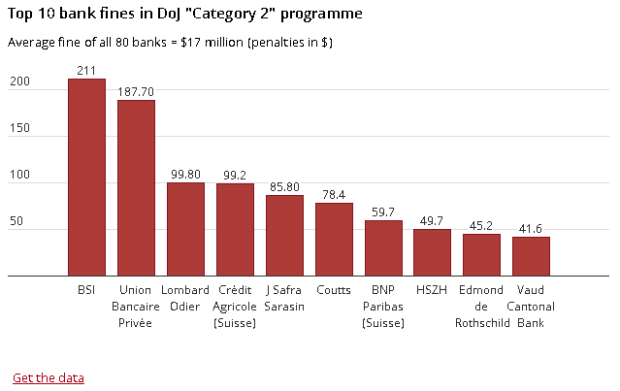Swiss-US tax evasion saga: where are we now?
swissinfo.ch charts the evolution of the long-running tax dodging dispute between Switzerland and the United States and looks at how far there is still to go before the final curtain can be drawn on the affair.
The United States wound up its “Category 2” tax evasion programme on Wednesday, netting $1.36 billion (CHF1.38 billion) from 80 Swiss banks that admitted helping US citizens cheat the tax man.
Let’s rewind to start with. How did the Swiss-US tax evasion row start?
The US had long suspected Swiss banks of harbouring US tax cheats (as did other countries). But Swiss banking secrecy made this impossible to prove.
That changed when former UBS employee Bradley Birkenfeld came to the Department of Justice (DoJ) with strong documentary evidence in 2007. The following year, the DoJ opened criminal proceedings against UBS and secured a $780 million fine in 2009.
However, other Swiss banks sensed an opportunity. They figured that because they did not operate on US soil they could get away with poaching UBS’s US tax cheats. The DoJ responded by indicting more Swiss banks, including the country’s oldest private bank Wegelin, which had to break up in 2012 before being convicted a year later.
So what exactly is Category 2?
There are actually four categories in the DoJ Swiss Bank Program. Category 2 refers to those banks – either Swiss or foreign institutions with a Swiss office – that held accounts belonging to US tax cheats.
The Swiss Bank Program was agreed in August, 2013, following intense diplomatic negotiations between the two countries. It was designed to allow those banks that were not already under active criminal investigation to own up to their offences and avoid potentially ruinous US courts cases. In essence, it was a diplomatic plea bargain compromise to stave off the threat of another Wegelin.
The scheme focused on US accounts held from August 1, 2008. After this date, banks would reasonably be expected to know the US stance on tax evasion following the criminal action begun against UBS. Any bank that retained US tax dodgers after this date, or worse still, poached accounts from other banks, could expect the DoJ to take action.
Category 1 banks were those under active prosecution before the deal was signed (more on that later). Category 3 banks declared that while they held US accounts, they were satisfied that they were tax compliant. Category 4 was reserved for Swiss banks with no US involvement.
A total bill of $1.36 billion. Does that make Category 2 a success?
It depends on how you look at it. The DoJ has certainly trumpeted the result as a resounding success. It has also secured $8 billion in backdated taxes and fines from Swiss bank clients and has enough documentary evidence to pursue lawyers and other facilitators.
The Bloomberg news agency has calculated that collectively the Category 2 banks held some $50 billion in US assets in 35,096 accounts between 2008 and 2013. The penalties equate to 2.7% of those assets. There may be people on the US side who see that as a poor return.
BSI private bank paid the biggest individual fine ($211 million) with the average fine standing at $17 million. In addition, banks have had to pay millions to lawyers and accountants to comply with the programme.
But numbers alone do not tell the whole story. The DoJ also published lurid details of banking activities with each agreement. These included the opening of sham companies and trusts to hide identities and bank staff secretly handing over cash and gold bullion to clients. This is bound to have an adverse impact on the reputation of these institutions.
Finally, the Swiss Bank Program played a part in dismantling Swiss banking secrecy. From July 1, 2014, Swiss banks have been forced to tell the US authorities about every US citizen that opens an account with them.
That’s that?
Not so fast. We still have to deal with categories 1, 3 and 4. By definition, those 26 banks enrolled in the latter two categories have done nothing wrong. But several of the 106 banks that initially registered in the Swiss Bank Program by the end of 2013 later changed their status. That means that some banks changed their status from Category 2 to the less onerous 3 or 4.
That’s fine as long as the US agrees. But there could potentially be trouble for any bank that wrongly registered as 3 or 4, according to the DoJ definition of guilt.
And 11 Category 1 banks remain under active criminal investigation (two of which have folded). To recap, Category 1 are those banks that were under investigation before the Swiss Bank Program was agreed and so could not register under Category 2.
Here, the fines could be more spectacular. Credit Suisse was forced to pay out combined fines of $2.8 billion in 2014, but it was the largest bank under investigation and had not cooperated as fully as the DoJ wanted.
Earlier this month, Julius Bär said it had put aside some $550 million to settle its case and it is the largest remaining Category 1 bank. But we won’t know the full damage until the cases are completed, probably at some point this year.




